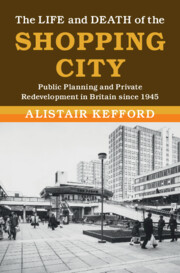 The Life and Death of the Shopping City
The Life and Death of the Shopping City Book contents
- The Life and Death of the Shopping City
- Modern British Histories
- The Life and Death of the Shopping City
- Copyright page
- Dedication
- Contents
- Figures
- Acknowledgements
- Introduction
- 1 Reconstructing Retail in the 1940s
- 2 Cities in the Age of Affluence
- 3 Making the Modern Shopping City
- 4 The Politics of Partnership
- 5 Landscapes of Leisure
- 6 Demand and Discontent in the Shopping City
- 7 Triumph of the Shopping City
- Conclusion
- List of Archives and Abbreviations
- Bibliography
- Index
4 - The Politics of Partnership
Published online by Cambridge University Press: 31 March 2022
- The Life and Death of the Shopping City
- Modern British Histories
- The Life and Death of the Shopping City
- Copyright page
- Dedication
- Contents
- Figures
- Acknowledgements
- Introduction
- 1 Reconstructing Retail in the 1940s
- 2 Cities in the Age of Affluence
- 3 Making the Modern Shopping City
- 4 The Politics of Partnership
- 5 Landscapes of Leisure
- 6 Demand and Discontent in the Shopping City
- 7 Triumph of the Shopping City
- Conclusion
- List of Archives and Abbreviations
- Bibliography
- Index
Summary
This chapter examines the politics and the practice of partnership in the urban renewal era. This public-private dynamic was the central political relationship which drove urban transformation; it was codified and mandated explicitly within planning legislation and central policy diktats and pursued energetically by many individual local authorities eager to remake the image and economy of their towns. I show how this hybrid, mixed economy of planning was situated within the wider political economy of post-war Britain, tracking the political influence and connections of the property and construction sectors as well as the attitudes and policy positions of both the Conservative and Labour Parties. I also trace the operation and impact of partnership-based urban renewal on the ground in various cities, focusing in particular on Manchester, Liverpool and Nottingham. Local authorities had a range of motivations for working with the commercial development sector and their experiences were not uniform. The chapter shows that some cities managed to navigate the new terrain of public-private developmentalism more successfully than others, but I also stress the basic asymmetries involved in these relationships, particularly for those places that were struggling most economically.
Keywords
- Type
- Chapter
- Information
- The Life and Death of the Shopping CityPublic Planning and Private Redevelopment in Britain since 1945, pp. 163 - 199Publisher: Cambridge University PressPrint publication year: 2022
